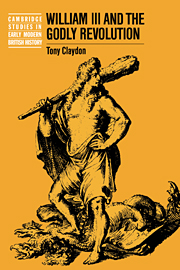Book contents
- Frontmatter
- Contents
- List of illustrations
- Acknowledgements
- List of abbreviations
- Notes on style
- Introduction
- 1 Courtly reformation and the revolution of 1688–1689
- 2 The resources for royal propaganda
- 3 The propagation of courtly reformation
- 4 Courtly reformation, the war, and the English nation
- 5 Courtly reformation and the politics of party
- 6 Courtly reformation and country politics
- Conclusion
- Bibliography
- Index
- Cambridge Studies in Early Modern British History
2 - The resources for royal propaganda
Published online by Cambridge University Press: 09 October 2009
- Frontmatter
- Contents
- List of illustrations
- Acknowledgements
- List of abbreviations
- Notes on style
- Introduction
- 1 Courtly reformation and the revolution of 1688–1689
- 2 The resources for royal propaganda
- 3 The propagation of courtly reformation
- 4 Courtly reformation, the war, and the English nation
- 5 Courtly reformation and the politics of party
- 6 Courtly reformation and country politics
- Conclusion
- Bibliography
- Index
- Cambridge Studies in Early Modern British History
Summary
REFORMATION PERSONNEL
On 31 December 1701, William III went to Westminster to deliver his last speech to parliament. Two months later, a rodent would succeed where Jacobite plotters had failed, and the king would die after his horse had stumbled over a molehill in Hyde Park. William's last speech was given nearly twelve years after he had first addressed the English as their monarch, but in that time the royal message had changed little. For one last time he rehearsed his claims for courtly reformation. Towards the end of his speech he hoped ‘what time can be spared, will be employed about those other very desirable things, which I have so often recommended from the throne; I mean, the forming of some good bills, for employing the poor, for encouraging trade, and the further suppressing of vice.’ As William's words suggested, this last appeal for moral renewal was merely the most recent instance of a continuing performance. Throughout his reign, the king had constantly advanced the tenets of reformation, and had tirelessly repeated his invitation to godly renewal. By 1701, William's subjects had experienced one of the heaviest polemical bombardments ever suffered by loyal Englishmen. The next two chapters will attempt to do justice to this royal effort. The first will describe the human and material tools which were available to William.
- Type
- Chapter
- Information
- William III and the Godly Revolution , pp. 64 - 89Publisher: Cambridge University PressPrint publication year: 1996



